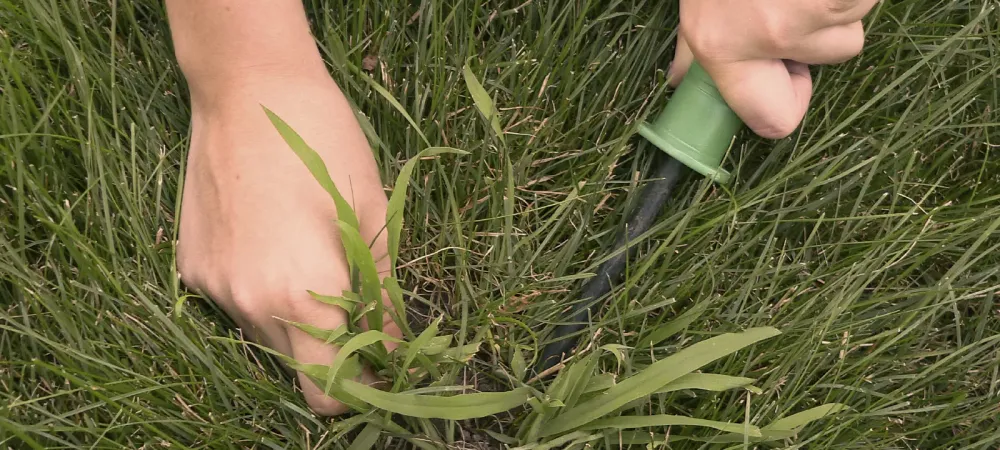Common Lawn Weeds in Ohio

Types of Weeds in Ohio
Ohio’s multi-seasonal climate can cause a wide range of lawn weed types to pop up in your yard. Identifying weeds in your yard can be done by noticing a few key characteristics:
- Leaf shape.
- Leaf structure.
- Arrangement of leaves on the stem.
- Flower structure, size, and color.
- The habit of growth.
- Life cycle.
Crabgrass
Crabgrass is a troublesome yet harmless weed that can grow all across your lawn. While it grows in the same color as your grass, it can be identified by its mangled and sharp appearance, which makes it stand out from the rest of your lawn. Crabgrass is caused by an improperly developed yard and can be handled with several basic lawn care techniques, such as lawn aeration, lawn fertilization, and weed control.
Dandelions
The dandelion’s bright yellow appearance, followed by its white, puffy, wish-giving seed pods, makes it one of the most recognizable weeds in North America. They’re a perennial weed, meaning they will return year after year without proper treatment. Dandelions are spread through the wind, making them an easily propagated species that pop up virtually everywhere.
Sedge
Sedge is from a plant family directly adjacent to grass called Cyperaceae. An easy way to differentiate sedge from grass is by noticing the triangular sheaths that cover the stem. Ohio is actually home to 230 different species of sedge, making it one of the most commonly found weeds in the state. While botanists love sedge, it can cause an unsightly appearance to your yard and can be quickly resolved with identification and removal.
Dollar Weed
Dollar weed, also known as pennywort, occurs during the warm seasons of spring and summer. It appears in lawns looking similar to mini lily pads with round, bright green, fleshy leaves. Because of its easily propagated nature (similar to the dandelion), full eradication of the dollar weed from your yard is unlikely. Instead, weed control techniques like cultural and chemical control are the best way to approach this weed.
When to Start Weed Control
Weed control is best implemented as soon as possible, so knowledge is key to identifying a weed problem and promptly determining your best course of action. Whether you choose DIY techniques or professional help, it’s important to begin looking for weed growth as soon as the snow melts to get a leg up on the weeds in your yard.
Spring Weed Control
Spring weed control is often the most effective method in Ohio because of its preventative nature. The trapped moisture and lack of air circulation caused by heavy Ohio snowfall can cause a slew of lawn care issues, such as fungal diseases. The dead grass left behind by the cold winter months can also make it easy for weeds to make their way into your yard, as it is left vulnerable.
How to Get Rid of Weeds
As a homeowner, it’s important to know the most effective ways to get rid of weeds. Below, we will talk about the two most common types of weed control: pre-emergent and post-emergent. Both have their benefits, but are best in tandem.
Pre-emergent Weed Control
Pre-emergent weed control works by creating a chemical barrier in the top layer of soil. This chemical barrier coats the seeds of easily propagated weeds and prevents them from growing. They are also used to reduce the presence of crabgrass in the yard. As the name implies, pre-emergent weed control is best used before the weeds appear, so it’s definitely a spring weed control must-have.
Post-emergent Weed Control
Sometimes life gets busy, and the appearance of our lawn gets away from us. If you’ve recently looked at your lawn and realized it’s overgrown with weeds, then a post-emergent weed treatment method is best for you. There are four different types of post-emergent pesticides:
- Systemic— These are absorbed directly into the plant to kill it from the root to the bud.
- Contact— These leave a coating on the plant to prevent it from photosynthesizing and continuing its growth.
- Selective— These target specific weeds and won’t destroy surrounding grass and plants.
- Non-selective— These destroy a broad area of application and should be used carefully so as not to destroy your whole yard.
The best time to apply post-emergent pesticides is after pre-emergent treatment in early to late spring when weeds are still in their growing process. Don’t forget to apply any weed treatment at dawn or dusk for optimal penetration and effectiveness.
Contact Land Art for Weed Control
If this all seems like too much for you, then leave the work to us. Land Art consists of a team of fully trained professionals ready to handle any weed issue you may have.
